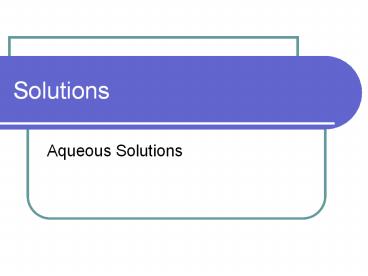Solutions - PowerPoint PPT Presentation
1 / 19
Title: Solutions
1
Solutions
- Aqueous Solutions
2
Review
- How do ionic and molecular compounds differ?
- The molecules in molecular compounds are
electrically neutral, covalently bonded groups of
atoms that behave as a unit. Ionic compounds are
huge collections of cations and anions.
3
Reivew
- What is a cation?
- A positive ion
- What is an anion?
- A negative ion
- Why are ionic compounds generally soluble in
water? - The cations and anions are attracted to the
charged ends of polar H2O molecules.
4
Solvents and Solutes
- Aqueous solution
- A solution in which the solvent is water
- Solvent
- The dissolving medium in a solution
- Solute
- The dissolved particles in a solution
5
Solvents and Solutes
- What are some of the properties of solutions?
- They are stable (they dont settle out over time)
- Particles/ion are less than 0.1 nanometers in
diameter - They cannot be separated by filtration
6
The Solution Process
- Solvation
- A process that occurs when an ionic solute
dissolves - In solution, the ions are surrounded by solvent
molecules - What is meant by like dissolves like?
- This refers to the polarity of the compounds
7
(No Transcript)
8
Electrolytes and Nonelectrolytes
- Electrolytes
- A compound that conducts an electrical current in
aqueous solution or in the molten state - All ionic compounds are electrolytes, but most
covalent compounds are not - Some polar covalent compounds form polyatomic
ions when dissolved in water - These compounds are electrolytes
9
Electrolytes and Nonelectrolytes
- Nonelectrolytes
- A compound that does not conduct an electric
current in aqueous solution or in the molten
state - Weak electrolytes
- A solution in which only a fraction of the solute
exists as ions. - Strong electrolytes
- A solution in which a large portion of the solute
exists as ions.
10
Water of Hydration
- Water of hydration
- Water molecules that are an integral part of a
crystalline structure - Written as (ionic formula unit)H2O
- The tells you how many water molecules per
ionic formula unit - If the water is there it is called a hydrate. If
the water is not there (when it usually is) it is
called the anhydrate. The two forms often have
different colors.
11
Water of Hydration
- Effloresce
- To lose the water of hydration
- Hydroscopic
- A term describing compounds that remove water
from the air - Desiccant
- A hydroscopic substance used as a drying agent
- Deliquescent
- A term describing a substance that removes enough
water from the air to form a solution
12
Water of Hydration
- You can use the formula of a a hydrate to
calculate its percent by mass water.
13
Water of Hydration
- Example Calculate the percent mass of water in
Epsom salt, MgSO47H2O
14
Heterogeneous Aqueous Solutions
- What is a heterogeneous mixture?
- One with different parts, like sand in water
15
Suspensions
- Suspensions
- A mixture from which some of particles settle out
slowly upon standing - Muddy water
- The particles are about 100 nm in diameter and
can be filtered out
16
Colloids
- Colloid
- A mixture whose particles are intermediate in
size between those of a suspension and a solution - These cannot be filtered
- Jello is a colliod.
17
Colloids
- Dispersed phase
- The particles in a colloid
- Usually between 0.1 nm and 100 nm in diameter
- Dispersing medium
- The substance a colloid is made in
18
Colloids
- Tyndall effect
- Scattering of light by particles in a colloid or
suspension, which causes the beam to become
visible - Brownian motion
- The chaotic movement of colloidal particles,
caused by collision with particles of the
dispersing medium
19
Colloids
- Emulsions
- Colloids of liquids in liquids (like shaking oil
and vinegar to mix them together) - Adding an emulsifier makes the emulsion stable
- Add flour to oil and water to make gravy
- Add parmesan cheese to butter and cream to make
Alfredo sauce - Add egg yolk to oil and vinegar to make mayonnaise































